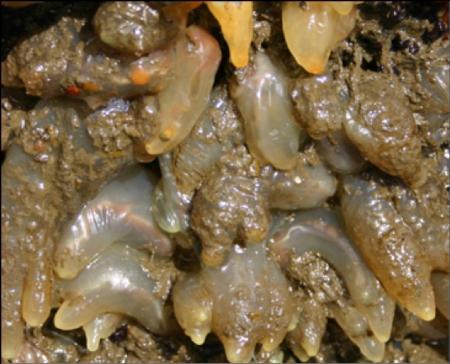Solitary Sea Squirts or Tunicate
-
Scientific Name
Ciona spp. (C. intestinalis, & C. savignyi) - Visit ITIS for full scientific classification.
-
Description
 Ciona spp. Photo by Carrie Culver © 2008 Regents, University of California.
Ciona spp. Photo by Carrie Culver © 2008 Regents, University of California.- Solitary tunicates ("sea squirts") with cylindrical-shaped bodies that can grow to about 6 inches long.
- Soft, gelatinous bodies attach to surfaces.
- Translucent and creamy yellowish-green in color.
- Their sac-like body is filled with water being brought in through an incurrent siphon (or tubular opening).
- They filter-feed on particles brought in with the water current, and push waste water back outside the body through the excurrent siphon.
-
Habitat
- Marine environments.
- Occurring in low intertidal to subtidal areas.
- Found attached to a variety of surfaces including rocks, woody debris, and vessel hulls in marinas.
-
Invasion Pathways and Distribution
- Spread by attaching to vessel hulls, from which larvae swim to settle on surfaces in marinas.
- Very broad global distribution, and native ranges are difficult to determine.
- C. intestinalis appears to be native to the North Atlantic, and C. savignyi to Japan and possibly Alaska.
- Non-natives in California.
- See NEMESIS for distribution maps.
-
Life History
- Pumps water through its siphons and filters food particles from the water.
- Reproduce sexually by releasing sperm and eggs into the water, where they unite to form swimming larvae.
-
Impacts
- This fouling growth roughens the hull’s surface, creating friction or “drag” that slows sailboats and increases fuel consumption for powerboats.
- Tolerant of copper in antifouling paint.
- Filter large amounts of water, thus reducing amount of food available for native species.
-
References and Useful Links
For references by category and links to other useful AIS sites see our LEARN MORE page.

